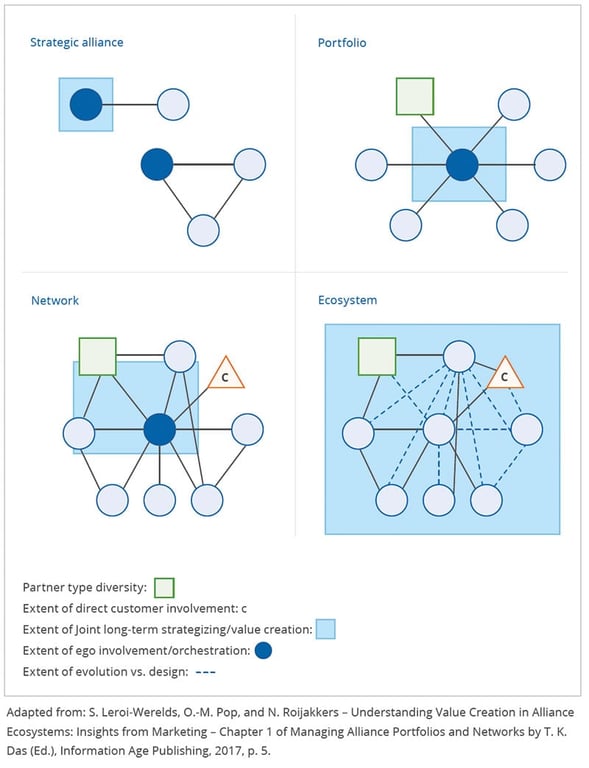In the same way, you can never go backward to a slower computer, you can never go backward to a lessened state of connectedness.
- Douglas Coupland, Canadian novelist and artist, author of “Generation X”
Healthcare, education, entertainment, spending habits, thinking patterns … The Information Age has revolutionized all of them. Fortunately, the process of partnering for innovation has not remained immune to technological progress either. In the same way that Millennials will never experience a world without connectivity or mobile devices, companies will never return to a lesser state of connectedness.
How so?
The short answer is open innovation.
From the first alliances in IT and healthcare in the 1970s to modern-day partner ecosystems of co-created value, collaboration for innovation is taking new and exciting forms. Not only do these new collaborative relationships require distinct ways to think about resources, they also encourage innovating for the greater good.
Pressured by increasing competition, shorter product lifecycles, and increased risk, companies today recognize the advantages of connecting to a variety of collaborators and collaborator types. In other words, the perception of collaboration is shifting. With it, firms’ outlook, protection mechanisms, and missions are shifting too.
The result?
Long-term focus, less focus on protecting IP, and more joint strategizing. Above all, the activity of an organization is no longer about individual well-being. Today, there is more and more talk about ensuring the survival of the whole.
Here, we describe today’s four main types of collaboration and the importance of each.
1. Strategic alliances
The most basic and longstanding type of collaboration for innovation is the strategic alliance. Strategic alliances are agreements between two or more independent firms that temporarily combine resources and efforts to reach their strategic goals.
Alliances made headlines in the 1970s and 1980s when multinationals in IT (IBM, Microsoft, Apple), semiconductors (Intel), and biotechnology (Roche, Genentech, Eli Lilly) were experiencing the limitations of their own internal resources. As a result, they began tapping into externally available assets to increase their competitiveness and reach evermore complex goals.
Benefits of strategic alliances
The main reasons to engage in a strategic alliance, and through this, ensure continuous innovation, included to:
- Compensate for in-house weaknesses or technological gaps
- Establish new product lines and portfolios
- Successfully enter new markets
- Serve customers better
- Reduce NPD (new product development) costs, risks, and time
In the strategic alliance era, collaboration meant creating formal, all-encompassing legal arrangements that allowed firms to exert a strong influence on their partners. Technology swapping, joint projects, and equity stakes were all undertaken to have a greater say in a partner’s innovation projects, and to cash in on the profits, of course.
While formal control was largely the norm, the advantages of collaboration through looser coordination began to show. In other words, collaboration moved forward.
2. A portfolio of collaborators
The second type of collaborative arrangement, often still used today, is through building a portfolio of collaborators.
Having understood the benefits of creating alliances, firms were now interested in sustaining their benefits for longer. As such, alliances began to be centrally managed, and the practice of building portfolios gained ground.
In effect, portfolio management was all about extracting best practices from alliance experiences and then spreading these internally. In this process, firm established agreements with independent companies but then managed the knowledge flows through specific functions.
Traditionally, large pharmaceutical companies have been excellent portfolio builders. In the industry’s beginnings, these firms would often collaborate with small biotechnological firms to assimilate knowledge and patents in the most efficient and effective manner. While conflicts were frequent at the start – small biotechs often felt “robbed” of their key resources – collaboration moved on. Effective portfolio management models were the key to this success.
All in all, the growing popularity of portfolio management translated into a new attitude toward collaborators. This attitude would later become the “co-creation” view, which we will come on to shortly.

3. Innovation Networks
The third type of collaboration for innovation is the network.
Networks include groups of firms that share R&D goals related to products, services, processes, or business models.
Complex network structures are natural progressions of alliances and portfolios. As collaboration tools and practices spread from high-tech to medium- and low-tech sectors, new ways of structuring innovation activity emerged. The key difference: All firms were now interconnected, orchestration became less strict, and low-to-medium competition replaced fierce battles for survival.
In time, networks started competing against each other. Suppliers, complementors, competitors, and even customers could now contribute to the innovation process in new and surprising ways. In addition, firms were no longer concerned with managing individual collaborations and ties. They were now managing their position in the network.
Benefits of innovation networks
Despite higher coordination costs, the benefits of networks soon became apparent. Networks were mainly used to:
- Scan firms’ environments for technological advances
- Quickly develop individual and group capabilities
- Secure long-term survival
All in all, networks emphasized more than ever the collective well-being of the collaborators.
4. Partner ecosystems
The fourth and most advanced type of collaboration for innovation is the partner ecosystem.
In their 2016 HBR piece called “The Ecosystem of Co-created Value”, authors Marc Kramer and Mark Pfitzer make a strong case for partner ecosystems. From their work, we learn not only how ubiquitous ecosystems have become but we also begin to understand their power to improve individual and collective well-being.
Today, companies like Salesforce (client relationship management systems), IMEC (nano electronics), Korean Air (air travel), and ENEL (electricity and gas distribution) are just a few examples of how ecosystems can and should be used to create value that no single organization can create on its own.
While a generally accepted definition of ecosystems is lacking, scholars like Ron Adner who is well known for his books "The Wide Lens: What Successful Innovators See that Others Miss" (2012) and "Winning the Right Game: How to Disrupt, Defend, and Deliver in a Changing" (2021) World, have highlighted some key characteristics. In Adner’s view, ecosystems have a long-term orientation, are partly self-adjusting, and make complex interdependencies between various types of partners, including end customers, explicit.
Other prominent researchers, including Satish Nambisan and Robert Baron, add more nuances to what ecosystems are and examine how ecosystem partners co-evolve. In Nambisan and Baron’s view, ecosystems are “loosely interconnected networks of companies and other entities that coevolve capabilities around a shared set of technologies, knowledge, or skills, and work cooperatively and competitively to develop new products and services”.
The most comprehensive description of ecosystems, however, is captured by marketing experts. In their work, researchers Stephen Vargo and Robert Lusch define ecosystems as: “relatively self-contained, self-adjusting systems of resource-integrating actors connected by shared institutional arrangements and mutual value creation through service exchange”.
The latter view is extremely important for two reasons:
First, ecosystems are governed by certain rules and norms that influence the relationships between members.
Second, in ecosystems, value is uniquely determined by the collaborator(s) or customer(s). Hence, innovation is no longer in service of the focal firm. Innovation is now a jointly orchestrated activity.
The benefits of partner ecosystems
In summary, ecosystems are typically characterized by:
- The absence of formal authority
- Strong dependencies among members
- A common set of goals and objectives
- A shared set of (complementary) knowledge and skills
Within ecosystems, shared vision, shared enterprise, serving each other, helping each other create value, committing to each other, and pursuing jointly formulated strategies and goals hence become the norm.
Final thoughts
Effective collaboration can take many forms. From the first strategic alliances in IT and pharma to modern-day ecosystems in transportation, retailing, and utilities, companies and their collaborators are coming together to solve problems they couldn’t address alone. Self-stirring pots, smart thermostats, and 3-D printed bridges are all the product of ambitious collaboration.
But collaboration is not for everyone. Before deciding to invest in setting up sophisticated alliances, portfolios, innovation networks, or ecosystems, a firm must ask itself: “Do these means justify the end?” In other words, “Does partnering for innovation fit my firm’s strategic goals?”
To help answer those compelling questions, I leave you with a few excerpts from the “Strategic Alliance Best Process Workbook” by Robert Porter Lynch. While this work was published in 2001, its principles are just as relevant today.
Which type of collaboration is right for you?
Before starting to collaborate, ask yourself:
- What are your goals?
- What do your customers need?
- Can you achieve your objectives alone?
- Would collaboration help you compensate for your weaknesses and enhance your strengths? If so, how?
- What happens if you do nothing and maintain the current course? (a “go-it-alone strategy”)
If you find that collaboration could work well for your organization, the next step is to figure out which collaboration type is right for your business by asking yourself:
- What is my value as a partner in collaboration? What do I bring to the table?
- What do I expect of my partner(s)? What is on my wish list?











